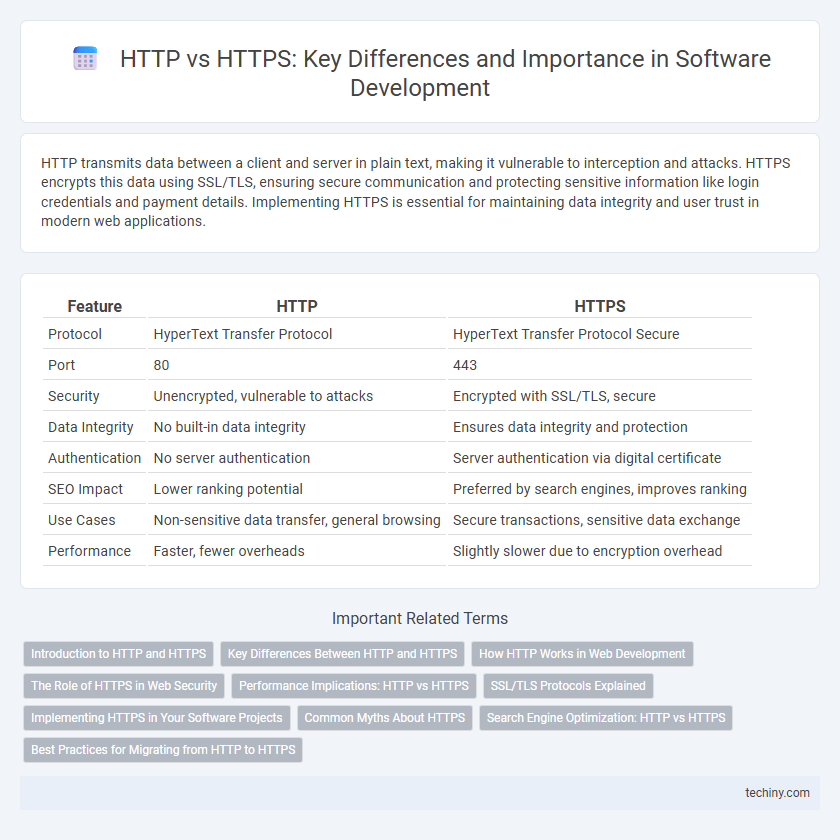HTTP transmits data between a client and server in plain text, making it vulnerable to interception and attacks. HTTPS encrypts this data using SSL/TLS, ensuring secure communication and protecting sensitive information like login credentials and payment details. Implementing HTTPS is essential for maintaining data integrity and user trust in modern web applications.
Table of Comparison
| Feature | HTTP | HTTPS |
|---|---|---|
| Protocol | HyperText Transfer Protocol | HyperText Transfer Protocol Secure |
| Port | 80 | 443 |
| Security | Unencrypted, vulnerable to attacks | Encrypted with SSL/TLS, secure |
| Data Integrity | No built-in data integrity | Ensures data integrity and protection |
| Authentication | No server authentication | Server authentication via digital certificate |
| SEO Impact | Lower ranking potential | Preferred by search engines, improves ranking |
| Use Cases | Non-sensitive data transfer, general browsing | Secure transactions, sensitive data exchange |
| Performance | Faster, fewer overheads | Slightly slower due to encryption overhead |
Introduction to HTTP and HTTPS
HTTP (Hypertext Transfer Protocol) is the foundational protocol for data communication on the web, enabling the transfer of hypertext documents between a client and a server. HTTPS (Hypertext Transfer Protocol Secure) extends HTTP by incorporating SSL/TLS encryption to ensure secure, encrypted communication that protects data integrity and confidentiality during transmission. The adoption of HTTPS is critical for safeguarding sensitive information, preventing eavesdropping, and enhancing user trust in web applications.
Key Differences Between HTTP and HTTPS
HTTP operates over port 80 and transmits data in plaintext, making it vulnerable to interception and man-in-the-middle attacks, whereas HTTPS uses port 443 and encrypts data with SSL/TLS protocols for secure communication. HTTPS ensures data integrity, authentication, and confidentiality by employing SSL certificates, which HTTP lacks, leading to higher trust and protection for web users. Performance-wise, HTTPS can leverage HTTP/2 for faster loading speeds despite the overhead of encryption, while HTTP remains unencrypted and susceptible to security risks.
How HTTP Works in Web Development
HTTP operates as a stateless protocol within web development, transmitting hypertext requests and responses between clients and servers using port 80 by default. When a user enters a URL, the browser sends an HTTP request to the web server, which processes it and returns the requested HTML content or other resources. HTTP's lack of encryption means data travels in plaintext, making it vulnerable to interception and attacks in web applications.
The Role of HTTPS in Web Security
HTTPS encrypts data transmitted between a user's browser and a web server, protecting sensitive information such as login credentials, payment details, and personal data from interception and tampering. It uses SSL/TLS protocols to establish a secure connection, enhancing trust and preventing man-in-the-middle attacks and data breaches. Web developers prioritize HTTPS implementation to ensure data integrity, confidentiality, and compliance with security standards like PCI DSS and GDPR.
Performance Implications: HTTP vs HTTPS
HTTPS introduces encryption overhead that can slightly increase latency compared to HTTP due to SSL/TLS handshakes and data encryption processes. Modern optimizations like HTTP/2 and hardware acceleration mitigate performance differences, often resulting in comparable or even improved load times for HTTPS. Prioritizing HTTPS ensures data security without significant compromise on performance, making it the preferred protocol for web applications.
SSL/TLS Protocols Explained
HTTP operates without encryption, exposing data to interception, while HTTPS secures communications using SSL/TLS protocols that encrypt data between the client and server. SSL (Secure Sockets Layer) and its successor TLS (Transport Layer Security) establish a secure channel by authenticating the server and encrypting transmitted information. Modern web browsers mandate TLS for HTTPS connections to ensure data integrity and confidentiality during online transactions and sensitive communications.
Implementing HTTPS in Your Software Projects
Implementing HTTPS in your software projects ensures data encryption and secure communication between clients and servers by leveraging SSL/TLS protocols, which protects sensitive information from interception or tampering. Migrating from HTTP to HTTPS involves obtaining an SSL/TLS certificate from a trusted Certificate Authority (CA), configuring the web server to handle secure connections, and redirecting all HTTP traffic to HTTPS to enforce secure access. Adoption of HTTPS enhances user trust, improves SEO rankings, and complies with security standards such as PCI-DSS and GDPR, making it essential for modern software development.
Common Myths About HTTPS
Many developers mistakenly believe HTTPS significantly slows down website performance, despite modern protocols like HTTP/2 mitigating latency issues. Another common myth is that HTTPS is only necessary for e-commerce sites, while in reality, it protects all data transfers, preventing man-in-the-middle attacks and preserving user privacy. Lastly, some assume HTTPS alone guarantees full website security, overlooking the need for robust backend security measures and regular vulnerability assessments.
Search Engine Optimization: HTTP vs HTTPS
HTTPS significantly enhances search engine optimization by providing a secure browsing experience, which search engines like Google prioritize in ranking algorithms. Websites using HTTPS benefit from improved trust signals, higher click-through rates, and potential boosts in search rankings compared to HTTP sites. Transitioning from HTTP to HTTPS also enables access to advanced web features and analytics tools that further optimize SEO performance.
Best Practices for Migrating from HTTP to HTTPS
Migrating from HTTP to HTTPS requires obtaining a valid SSL/TLS certificate and configuring the web server to enforce HTTPS connections with 301 redirects, ensuring all URLs automatically switch from HTTP. Updating internal links, APIs, and external references to HTTPS prevents mixed content issues and enhances site security. Testing the migration thoroughly with tools like SSL Labs and monitoring for performance impact ensures a smooth transition and maintains SEO rankings.
HTTP vs HTTPS Infographic

 techiny.com
techiny.com